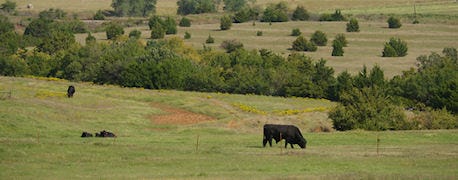December 28, 2012

In the prolonged summer drought, farmers noticed that grass stayed green longer in their hayfields than in their pastures; while hayfields kept growing, pastures turned brown, and cows ran out of grass to graze.
Dennis Hancock, University of Georgia Extension forage specialist, says the difference is in the length of the roots. Grass that is grazed every day doesn't develop roots as deep as grass of the same species allowed to grow uncut for a month.
"Allowed to grow, grass roots will go down and find water," Hancock noted. Forage crops can withstand the usual summer dry periods, but they must be given a chance to grow and develop deep roots.

Deep roots help grass stay green in dry spell; grazing grass too short kills off root systems
The unseen loss from continuously grazed pastures is the killing of roots, he said. If leaves are continuously clipped, the roots die back. There's not enough photosynthesis to feed the roots. That's when lack of roots cuts the supply of water to the leaves.
Lack of strong roots on pasture grasses results in great loss to livestock producers. Unmanaged grazing cuts losses further.
On continuously grazed pastures, cattle get only 30 to 40% of the growth. Rotational grazing, moving livestock off the pasture before all the leaves are eaten, improves total growth. Dividing a pasture into just four paddocks and rotating animals improves efficiency to above 60%.
"There is lots of room for improvement," Hancock said. "If you had only 30% efficiency feeding your corn, you would do something about it."
Rapid growth stage ideal for grazing
In a short lesson on grass biology, Hancock explained why grass should be grazed during the rapid growth stage. Production efficiency peaks then.
In early growth, nipping new grass too soon stunts plants. Roots fail to grow deep. At the reproductive stage, when plants set seed, growth stops. Leaves become fibrous when nutrients move into the seed head.
The rest period for forage determines the success of the grazing system. MU has developed a "grazing wedge" tool that is customizable for both dairy and beef producers.
To graph the wedge, producers measure dry-matter growth in each paddock with a rising plate meter. The graph shows which paddock to graze next. This helps prevent paddocks from going into the reproductive stage before they are grazed. Each paddock can be grazed at peak production in the rapid-growth stage.
Letting the livestock graze the forage, instead of harvesting and feeding it, is the way to increase profits. "Baled hay is the biggest block to profits," Hancock said. "If you need hay, let your neighbor grow and bale it."
Hancock left a challenge for producers: "There's no reason not to have a 300-day grazing season. Grazing grass can eliminate most of a 120-day hay-feeding season each winter. The goal is not to unroll a bale of hay."
Pasture grasses can be stockpiled, ungrazed, in the fall growing season. That forage can be grazed by livestock through most of the winter.
Source: MU Extension
You May Also Like




